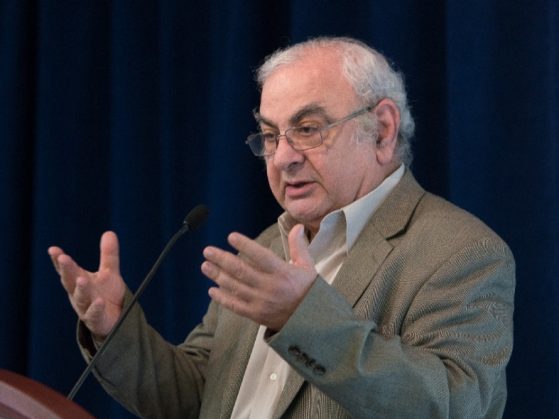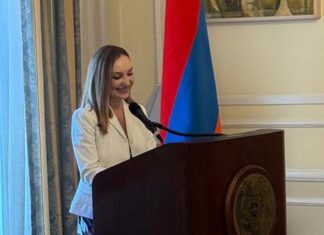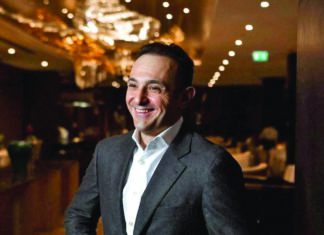By Muriel Mirak-Weissbach
Special to the Mirror-Spectator
FRANKFURT, Germany — Among the hundreds of thousands of new titles exhibited at the Frankfurt book fair, the largest such fair in the world, are numerous studies on Armenia published this year, the centenary of the genocide. The Fachbuchjournal, a bi-monthly publication that reviews non-fiction works, issued its book fair edition with a special focus on this theme, referencing 20 works, twelve of them with extensive reviews. In an in-depth interview which opens the section, Wolfgang Gust, who published the relevant documents from the Foreign Ministry archives of Ottoman Turkey’s wartime ally Imperial Germany, comments on the status of genocide studies and the significance of centenary events.
The three “very excellent contributions” to the centenary in Gust’s view, were the special mass celebrated by Pope Francis at St. Peter’s, the speech delivered by German President Gauck on April 24 in Berlin, and the debate in the Bundestag (Parliament) that followed. In all three, the events of 1915 were called by their proper name — genocide — and bold proposals were aired to assist Turkey in coming to terms with its past. Gust also highlighted an ambitious program of 40 commemorative events organized in Berlin by the Gorki Theater, on the initiative of persons of Turkish-German background.
Gust applauds the achievements (albeit not new) in German language studies contributed by Swiss scholars, among them Christoph Dinkel, Dominik Schaller and Hans Lukas Kieser, all of whom have examined the German role in the genocide. By contrast, Gust laments the relative lack of such studies in Germany itself, noting for example that there is only one History Department of one university where academic research into the German co-responsibility is possible. Prof. Mihran Dabag of Bochum University and Kristin Platt have just released their book, Verlust und Vermächtnis, Überlebende des Genozids an den Armeniern erinnern sich (“Loss and Legacy: Armenian Genocide Survivors Recollect”), which Gust points to as “a pretty big treasure”, although it does not treat the German role specifically.
To explain why this particular aspect has remained largely in the dark, Gust recalled his youth, and “how Germans spoke about the Shoa, namely, almost not at all.” It took almost a quarter century after the war before Nazi criminals were brought to trial and only in 1968 did the Germans start in earnest to process the past; Gust adds, “and working through the Armenian genocide lies ahead of us still, because many think, ‘For God’s sake, now not yet another genocide, the Armenian one!’” Having done the research himself on this aspect, Gust explained just what the German archive material reveals: what the German diplomats and military knew and what they did or did not do.
What’s New In 2015
There are three new German publications he singles out for attention: Michael Hesemann’s book, Völkermord an den Armeniern (“The Armenian Genocide”) he finds particularly important “because it contains new research results and heretofore unpublished documents from the Vatican secret archives.” The importance of Jürgen Gottschlich’s Beihilfe zum Völkermord (“Accomplice to Genocide”) lies in the intensive research conducted into the role of the German military, says Gust. And another new release with important documentation is Der Völkermord an den Armeniern im Spiegel der deutschsprachigen Tagespresse 1912-1922 (“The Armenian Genocide as Reflected in the German-language Daily Press 1912-1922”) by Yetvart Ficiciyan.
It becomes clear, in a detailed review, just why Gottschlich explored the question, “what occurred, how, when and for what reason, and what role Germany played.” As a long-term correspondent in Turkey for the Berlin-based Tageszeitung, he was often asked by Armenians and Turks alike about the co-responsibility of the Germans, and at the same time realized that Germans knew little or nothing about this chapter in their history. In his book, Gottschlich recreates the scene of the crime, so to speak, taking his reader along with him to landmarks of the genocide which he visited extensively, be it in Van or Musa Dagh, where Armenians resisted, or the Kemagh gorge from whose heights thousands were thrown to their death in the Euphrates. As anticipated in his title, the author holds the German military co-responsible, specifically Lt. Gen. Fritz Bronsart von Schellendorf, who admitted in a secret report to Ludendorff in 1917 that he had organized the preparations for the general mobilization of the Turkish army already in February 1914. On the basis of this documented fact the author moots that Bronsart later, as General Chief of Staff of the Ottoman army, also drew up the June 1, 1915 deportation orders and proposed plans for implementation. Although Talaat Pasha implicated Bronsart by name in his memoirs published in 1946, Gottschlich acknowledges that direct documents proving this are still to be found — perhaps in Turkish General Staff archives.
Hesemann also provides new insights into the genocide, this time through documents he has studied since 2008 in the Vatican archives. Two focal points emerge from his research: first, the fate of the Catholics and, secondly, the attempts by the papacy to halt the carnage. Although the Catholics constituted the smallest group among Armenian Christians, overall, Catholics were well represented, with 12 dioceses, numerous cloisters, monasteries, schools and communities throughout the Ottoman Empire, and when the genocide began, they were also targeted. Pope Benedict XV, who was elected in September 1914, was to become known as the “Peace Pope” for his indefatigable efforts to stop the massacres, save the Catholics and all Christians. His first encyclical denounced the senselessness of war. He worked through Catholic networks in Istanbul, Mosul, Jerusalem, Vienna and Munich, deploying his diplomatic representatives in hopes of exerting influence on Turkey through Germany and Austria. When this failed, he appealed directly to the Austrian and German Emperors, as well as to Sultan Mehmet V. As such initiatives met no success, the documents show how Catholics despaired, realizing that the Young Turk regime intended to annihilate all Christian life. The author makes clear his aim is not only to provide new documentation but to issue a warning that continued genocide denial may lead to renewed atrocities. Here he refers to the lessons drawn by Hitler and the Nazis, as well as Mussolini, from the Young Turk experience.
Yetvart Ficiciyan, a leading member of the Armenian community in Berlin, sheds new light on what public opinion in Germany in the decade including the war years learned or did not learn from the press reports. His careful monitoring of the daily press between 1910-1922 shows the complex web of factors involved in the genocide, from the Turks and Kurds, to the Great Powers (Russia, England, France, Austro-Hungary, Italy, the US), as well as Switzerland, the Balkans and the Vatican, and of course Germany, seen as the responsible for the outbreak of war. There are moving reports on the fate of the deportees during the death marches and accounts of the celebrated trial of Talaat’s assassin Teilirian, who was acquitted. The publisher, Donat, has been recognized as a leader in issuing books on Armenia, among them two other new titles this year: Harry Stürmer’s Zwei Kriegsjahre in Konstantinopel 1915-1916 (“Two War Years in Constantinople 1915-1916”), which was banned in Germany shortly after its appearance in Lausanne in 1917, and Entscheidung in Aleppo – Konsul Walter Rössler (1871 -1929) (“Decision in Aleppo – Consul Walter Rossler 1871 – 1929”), a biography of a man who helped the Armenians, by Kai Seyffarth. Donat has also published Heinrich Vierbücher’s Armenien 1915 which appeared in English translation a few years ago.
From Rolf Hosfeld, scientific director of the Lepsius House in Potsdam and a prolific author, we have a new, extremely well documented account of the genocide titled Tod in der Wüste (“Death in the Desert”). Especially for readers who are approaching the subject for the first time, this carefully researched study presents the Aghet in detail, how it unfolded, who the Young Turk perpetrators were, what motivated their search for the “final solution” to the Armenian problem and much more. And it leaves no room for doubt that this was indeed genocide, the case which Lemkin in fact used to formulate the juridical definition of this crime. One criticism raised by several reviewers is that the author has left the matter of German complicity virtually untouched.
The Survivors Speak Out
No matter how detailed and exhaustive such historical studies may be, in presenting the facts of the genocide, it is the personal accounts of those who miraculously survived which open the hearts and minds of modern day readers to the human dimension of what has been called an “unspeakable” tragedy. Among the books in this category released this year in Germany is the volume referenced above, by Mirhan Dabag and Kristin Platt, Verlust und Vermächtnis, Überlebende des Genozids an den Armeniern erinnern sich (“Loss and Legacy: Armenian Genocide Survivors Recollect”). Professor Dabag, who is director of the Institute for Diaspora and Genocide Research at the Ruhr University in Bochum, and his colleague Dr. Kristin Platt, psychologist and trauma researcher, conducted 140 interviews in an oral history project in France, Holland, Italy and Cyprus, in the Armenian language, between 1989 and 1996. The seven personal memoirs they selected for publication in German translation come from Armenian men and women between 80 and 95 years old. Their recollections are as moving as archaic tragedies, expressed sometimes in laconic, factual terms – “We were like animals. We could not think.” – and sometimes in poetical force – “Men fell like fruits from a mulberry tree. Like mulberries they fell. The fell and they died. Without sound, without cry….” The book is not only a gripping historical document but a literary gem, the reviewer writes.
One of the earliest personal accounts of the genocide is by Pailadzo Captanian, published in 1919. Just released in Germany, titled, 1915 Der Völkermord an den Armeniern. Eine Zeugin berichtet (“1915 The Armenian Genocide. An Eyewitness Report”), its value, like that of other early such testimonies, lies not in its literary greatness but in its stark realism. What motivated her was the desire to provide other survivors with a truthful account of what occurred, and to urge “the civilized nations” to ensure that justice be done. Her saga, in short entries in a diary, tells of house searches in April 2015 in Samsun, followed by orders for Armenians to leave their homes in July, then offers to convert and be saved — an option she disdained and condemned. She details the horrors of the deportation marches, the rape of girls, hunger, thirst, death. Through a series of fortuitous incidents, the author manages to escape death and eventually to be reunited with family members. As is common in this early genocide literature, the author indulges often in stereotypes, presenting the Turks as brutal, inhumane and obsessed with possessions. The Germans fare no better, as she sees them as ultimately responsible. And, typical of this literature, her message is one of revenge. Yet optimism in the end prevails as she expresses her belief that a new Armenia will blossom and justice will be done.
Though not strictly speaking a survivor’s memoir, the little volume by Dr. Hagop Martin Deranian, President Calvin Coolidge and the Armenian Orphan Rug, has also recently appeared in a German translation. The publisher, Schiler-Verlag, has issued numerous books on Armenia, among them works by Hrant Dink, my book Through the Wall of Fire: Armenia, Iraq, Palestine: From Wrath to Reconciliation, and this year, a brand new translation of 28 poems by Paruyr Sevak, which will be presented this month in Yerevan as well.
German-Armenian Relations – From Enmity to Friendship
If the thrust of the newest studies in the German language has been to shed light on the German role in the genocide, a topic which had been taboo for many years, this most welcome development can only have a positive impact on relations – already friendly and fruitful — between Berlin and Yerevan. And on the occasion of the centenary, recognition of the history of German-Armenian relations has played an important function in defining and confirming deep-rooted cultural and historical ties. Among the organizations dedicated to strengthening this relationship is the Deutsch-Armenische Gesellschaft (DAG – German-Armenian Society), which celebrated its centenary in 2014, with a Festschrift. Already before the First World War there were important scientific and academic contacts, the most illustrious being that of the composer Komitas who studied in Berlin. When the reforms in the Ottoman Empire promoted by the DAG came to naught, and the genocide began, the association moved to assist survivors and inform world public opinion on the fate of the Armenians. In the period after the war, the DAG began to focus on developing relations between the two countries and has organized conferences and seminars, which have become an integral part of the discussion process in Germany.
The history of German-Armenian relations goes back even farther in history, much farther than one might think. Azat Ordukanyan, a historian and doctoral candidate at the Ruhr University Bochum, is head of the Deutsch-armenische Akademische Verein, the oldest German-Armenian organization. In a pamphlet first published in 2008, Ordukanyan tells the totally unknown story of the relations between Armenian and Germans, between Armenia and Germany, reaching far back in history. There are numerous German saints who are regularly honored in church services, for example, but no one knows that they were Armenians. Or who knows that the marriage of German Emperor Otto II with Theophanu, a Byzantine-Armenian princess, in the10th century would bring together the German Roman empire with Byzantium?
2015 Frankfurt Book Fair: New Studies on Armenia
Top 5 Articles
- Trending
- Most Viewed
- Most Commented
- Armenian Government Reportedly Pays $6 Million for Jennifer Lopez Concert
- If Azerbaijan Breaks its Agreements, Are Armenians Prepared to Resist?
- ‘Uncovering a Veil of Secrecy’
- In Thessaloniki, Armenians, Like Jews, Keep Their Culture Alive
- Assessing the Significance of the August 8 Armenia-Azerbaijan Documents
- Why I Am Grateful to Erdogan, the Dictator of Turkey
- A Political Whirlwind Engulfs Nagorno Karabakh
- Libya’s Interim Government Recognizes the Armenian Genocide Once Again
- Robert Bedrosian Marries High Tech With Ancient Armenian Manuscripts
- Aleppo Aid through St. Kevork Armenian Apostolic Church of Houston







